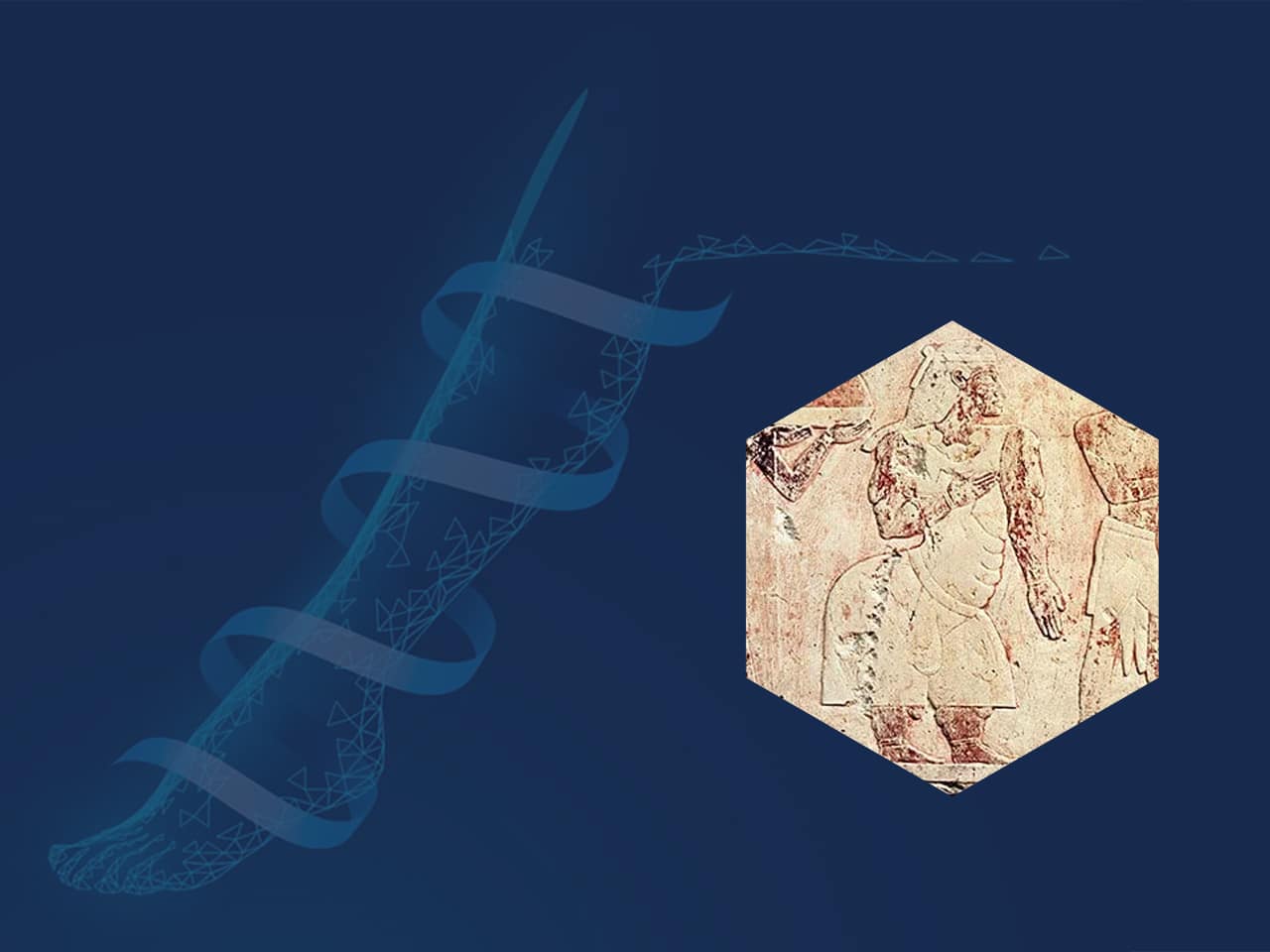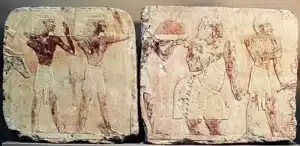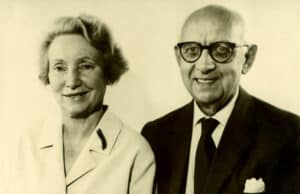Lymphedema is a condition that affects over 10 million people in the United States and millions more around the world. Lymphedema occurs when a dysfunction with the lymphatic system and a build-up of lymph fluid in the body causes swelling. Various factors, including genetics, injury, cancer treatment, and infections, can cause it. Although there is not yet a cure for lymphedema, treatment has evolved significantly over the years to help improve the management of this condition and quality of life. Let’s explore the history and evolution of lymphedema treatment and see how far we have come.
The Beginning
The oldest known possible case of lymphedema was found carved and painted on limestone, estimated to be from 1479-1458 BC. Now hanging in the Egyptian Museum in Cairo, this artwork shows Parehu, the ruler of Punt, located in what is now southern Sudan or Ethiopia. Behind him stands his wife, Ati, who is pictured with swollen or larger limbs and is thought to have lymphedema.
In medical literature, the oldest known description of lymphedema was recorded in the 6th or 7th century BC in ancient Indian text. In the Sushruta Samhita, a condition called Slipada, meaning elephant leg, is described as swelling in the limbs and other body parts. In this exact text, this condition is said to be caused by the accumulation of “kapha,” which is one of three energies that govern the body’s function in Ayurvedic medicine. The text also describes the first treatment for this condition, which included a combination of diet, lifestyle modifications, and medicines.
Later in the 5th century BC, Hippocrates described a condition called “elephantiasis,” which was characterized by swelling in the legs and was believed to be caused by a blockage in the lymphatic system. Hundreds of years later, the Roman physician Galen described lymphedema in the 2nd century AD. He identified it as a specific condition and recommended using exercise and massage to treat it.
Finally, in 807-870 AD, a Perusian physician named Ali ibn Sahl Rabban al-Tabbari described a disease called Daa al-Fil (daa = disease, fil = elephant). Following this, many medical books began to include similar descriptions of this condition.
It’s worth noting that the term “elephantiasis” has been used throughout history to refer to various conditions characterized by swelling, including lymphedema and other forms of lymphatic obstruction. It’s not specific and exactly clear the extent to which these descriptions align with our modern diagnosis and description of lymphedema compared to other conditions or diseases.
The History of Treatment
More modern treatment of lymphedema dates to 1869 when Professor von Monsegeil developed manual lymphatic drainage (MLD) for management. Soon after, in 1892, an Austrian-Belgian surgeon named Alexander von Winiwarter wrote a book titled “Billroth’s Book of German Surgery” and described the four pillars of lymphedema treatment: gentle lymphatic massage, inelastic bandaging, skin care, and exercise. These lymphedema treatments have continued to remain the foundation for lymphedema treatment for the next 130 years.
Historically, MLD was the primary treatment for lymphedema. MLD is a type of massage that helps to move lymph fluid out of the affected area and reduce swelling. In 1932, Emil and Estrid Vodder refined lymphatic drainage, which is the most well-known manual technique used today.
In 1979, the Földi Clinic was founded in Germany by Professor Michael Földi and Professor Etelka Földi. It was a specialty clinic set up as a hospital for extended lymphedema treatment. It originally had 60 beds, but the demand grew quickly, with a waitlist of over one year, so the team rented a nearby hotel to increase capacity by an additional 22 beds. To date, the clinic has grown to 170 beds with treatment that includes the four pillars described by Winiwarter, but also now includes nutritional and psychological support as well.
Lymphedema Treatment in the US
Lymphedema treatment in the United States began to build up in the late 1980s. A general surgeon in New York named Robert Lerner, MD, visited the Földi Clinic, where he studied their methods and founded the first lymphedema treatment center in the country. At Dr. Lerner’s Lymphedema Treatment Services Clinic, treatment was provided through bandaging, MLD, garment fitting, support groups, and more.
In 1998, Dr. Lerner teamed up with Guenter Klose, another graduate of the Földi Clinic program, and two other doctors. They published a research paper describing complete decongestive therapy (CDT) as an effective treatment for lymphedema, which was published in an American medical journal. In the years after, multiple certification programs and courses were created to train therapists, physicians, massage therapists, and other healthcare professionals. These courses average 135 hours and primarily teach the Vodder and Földi methods.
From the 1990s up until today, compression garments have expanded significantly. It has grown from basic compression garments into daytime circular knit, custom flat knit, night garments, lymphedema pads, foams, paddings, and more. There are garments and compression options for every part of the body with various levels of strength and fabric types to address all symptoms of lymphedema.
The frequency of treatment remains unique to the US compared to the German methods. Due to insurance coverage, treatment in the US does not follow Földi’s gold-standard treatment of 2 times a day for four weeks. Most treatment plans include therapy 2-4 times a week for 3-5 weeks of CDT, followed by self-management for ongoing treatment. Although private insurance companies have generally covered part or all of the cost of compression garments and supplies, Medicare has not, leaving many individuals without financial support to manage their condition. However, at the end of 2022, the Lymphedema Treatment Act was passed through Congress, which includes financial coverage for these supplies. It will likely go into effect in 2024 and provide support for millions of Americans.
Pneumatic Compression Devices
Pneumatic compression devices and pumps have been used for several decades as a treatment for lymphedema and other conditions that cause swelling in the arms or legs. The first pneumatic compression devices were developed in the 1950s and were used primarily in hospitals and rehabilitation centers. These early devices were large and bulky, making them difficult to use and transport. They were also relatively expensive and not widely available, limiting their use to specific patient populations.
Over time, pneumatic compression devices have become smaller and more portable, making them more convenient for use at home. They have also become more efficient, with improved compression patterns and the ability to customize treatment settings. Today, they are widely available and used by various patient populations, including individuals with lymphedema.
The Addition of Lymphedema Surgery
In recent years, new treatments for lymphedema have been developed, including:
- Liposuction-assisted lipectomy: a surgical procedure that removes hardened, thickened, and fibrotic tissue in the affected limb to reduce volume, reduce the risk of infections, and improve lymphatic flow.
- Lymphaticovenous anastomosis (LVA): a surgical procedure that involves connecting a lymphatic vessel to a vein to improve drainage and reduce swelling.
- Vascularized lymph node transfer (VLNT): a surgical procedure in which healthy lymph nodes are transplanted to the affected area to improve drainage and reduce swelling.
- Low-level laser therapy (LLLT): a non-invasive treatment that uses low-level lasers to stimulate the lymphatic system and improve drainage.
These treatments are generally used in combination with other therapies, such as compression therapy and manual lymphatic drainage, to manage the condition and improve quality of life. A growing number of surgeons worldwide have individual methods but continue to bring discussion and research to improve surgical and non-surgical techniques and outcomes for enhanced management of lymphedema. Often, patients will need multiple surgeries and must continue with modified CDT long-term. Still, the lymphedema is much less severe and better managed with lower infections, improved ability to move around, less pain, and improved quality of life.
What’s to Come?
Various programs and researchers around the globe continue to search for new surgeries, medications, and treatment options to optimize the management of lymphedema to find a cure. These healthcare professionals and researchers are using specialty imaging like lymphoscintigraphy and indocyanine green (ICG) to study and better understand the lymphatic system.
With these diagnostic tests, researchers at the ALERT program in Australia have found ways to map an individual’s lymphatic systems for more personalized treatment and manual lymphatic drainage. Surgeons worldwide are also improving surgical techniques with super microvascular surgery for improved lymphatic flow and function using this imaging. There are also researchers in the US working hard to find preventative procedures like lymph node transplants during surgery for cancer treatment to lower the risk of getting lymphedema.
Overall, the treatment of lymphedema has come a long way, with many options available to manage the condition and improve quality of life. Still, with growing technology and techniques, there remains a lot of hope for a better future for those living with this condition.
References:
van Oppen, Branko. (2020). Lovely Ugly Bes! Animalistic Aspects in Ancient Egyptian Popular Religion. Arts. 9. 51. 10.3390/arts9020051.
New Kingdom, 18th Dynasty, reign of Hatshepsut, ca. 1479-1458 BC. Carved and painted limestone, from Deir el-Bahari, West Thebes. Now in the Egyptian Museum, Cairo. JE 14276
The curse of Saint Thomas, Med Hist, 1970, vol. 14 (pg. 352-63)
Samad E. J. Golzari, Abolhassan Kazemi, Alireza Ghaffari, Kamyar Ghabili, A Brief History of Elephantiasis, Clinical Infectious Diseases, Volume 55, Issue 7, 1 October 2012, Page 1024, https://doi.org/10.1093/cid/cis569
Földi, M, E Földi: Földi’s Textbook of Lymphology. 2nd ed. Munich, Germany: Elsevier GmbH, 2006.
I., Tzani & M., Tsichlaki & Papathanasiou, George & Zerva, E. & Dimakakos, Evangelos. (2018). Physiotherapeutic rehabilitation of lymphedema: State-of-the-art. Lymphology. 51. 1-12.
MacDonald, John. “An American history of lymphoedema management.” Journal of Lymphoedema 1.1 (2006): 10-11.
Boyages J, Koelmeyer LA, Suami H, Lam T, Ngo QD, Heydon-White A, Czerniec S, Munot S, Ho-Shon K, Mackie H. The ALERT model of care for the assessment and personalized management of patients with lymphoedema. Br J Surg. 2020 Feb;107(3):238-247. doi: 10.1002/bjs.11368. Epub 2019 Nov 6. PMID: 31696506.


